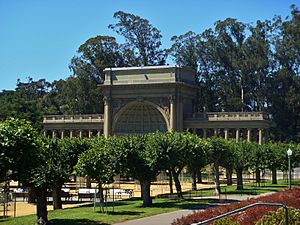Claus Spreckels facts for kids
Quick facts for kids
Claus Spreckels
|
|
|---|---|
 |
|
| Born | July 9, 1828 Lamstedt, Lower Saxony, Germany
|
| Died | December 26, 1908 (aged 80) San Francisco, California, U.S.
|
| Occupation | Industrialist |
| Known for | Founder of Spreckels Sugar Company |
| Spouse(s) | Anna Christina Mangels (1829-1910) |
| Children | 13, five lived to adulthood: John Diedrich (1853-1926), Adolph Bernard (1857-1924), Claus August (1858-1946), Rudolph (1872-1958), Emma Claudina Spreckels Hutton (1870-1924) |
| Signature | |
Claus Spreckels (born July 9, 1828 – died December 26, 1908) was a very important businessman. He was known as an industrialist. He made a big impact in both Hawaii and California.
Spreckels is most famous for starting the Spreckels Sugar Company. This company became a huge success. He played a key role in the sugar industry.
Contents
Early Life and New Beginnings
Claus Spreckels was born in a town called Lamstedt in Germany. This was in 1828. When he was 18, in 1846, he left his home country. He came to the United States to start a new life. He arrived with very little money.
In 1852, he married his childhood sweetheart, Anna Christina Mangels. She had moved to New York City a few years earlier. Claus and Anna had thirteen children together. Five of their children lived to be adults. These included his sons John, Adolph, Claus August, and Rudolph, and his daughter Emma.
Building Businesses in California
The Spreckels family first lived in South Carolina. There, Claus opened a grocery store. Soon after, they moved to New York City. In 1856, they settled in San Francisco, California. This is where Spreckels started a brewery.
In the mid-1860s, Spreckels got into the sugar business. He quickly became a leader in the sugar trade on the West Coast. His first sugar refinery was built in San Francisco in 1867. It was located at Eighth and Brannan Streets.
By the late 1870s, this refinery was too small. So, Spreckels built a much larger one. He chose a spot in Potrero Point because it had easy access to water. He named his new company the California Sugar Refinery.
Claus Spreckels used some of his money to buy land. Starting in 1872, he bought a large area called Rancho Aptos. This land was in Aptos, California. It was used for ranching and timber. He built a big resort hotel there. He also created a large ranch complex nearby.
Spreckels was one of the first people to invest in the Santa Cruz Railroad. This train line started running in 1875. It went through his land between Santa Cruz and Watsonville.
It was on his Aptos ranch that Spreckels began to try growing sugar beets. He encouraged other farmers in the area to plant sugar beets too. In 1874, he built a small refinery in nearby Capitola. It operated for five years.
In 1888, Spreckels started the Western Beet Sugar Company in Watsonville. At that time, it was the biggest beet sugar factory in the U.S. By 1890, Spreckels was growing most of his sugar beets in the Salinas Valley.
To transport his sugar beets, he built a 42-mile long narrow gauge railway. This railway was called the Pajaro Valley Consolidated Railroad. It shipped sugar beets from fields near Salinas to Watsonville.

In 1899, Spreckels opened an even bigger factory. It was closer to the main sugar beet fields. He named this new factory the Spreckels Sugar Company. A town grew up around the plant, which is still called Spreckels, California. This town and the sugar factory were important in the early life of the famous writer John Steinbeck. Many scenes from his novels take place there.
In the 1890s, Spreckels helped form a large group of sugar companies. He renamed his San Francisco property the Western Sugar Refinery. He kept increasing his control over the Hawaiian sugar trade. This control bothered some Hawaiian sugar growers.
By the end of the 1890s, they tried to become more independent. In 1905, these growers started their own refinery. It was in Crockett, California, and was called the California and Hawaiian Sugar Company (C&H). This broke Spreckels' complete control over the sugar industry. However, the Western Sugar Refinery in San Francisco continued to operate until 1951.
Spreckels was also the President of the San Francisco and San Joaquin Valley Railroad. This was from 1895 until 1901. The railroad was sold to the Santa Fe Railway. This railway built a line that competed with the Southern Pacific railroad. It ran through the San Joaquin Valley. This competition was good for businesses. It helped them get better shipping rates.
Adventures in Hawaii
Claus Spreckels became interested in Hawaii's sugar industry in 1876. At first, he was against a treaty that would make Hawaiian sugar cheaper to import. He worried it would hurt his own business. But then, Spreckels decided to start his own sugar farms in Hawaii. He traveled there in 1877.
In 1878, Spreckels created Spreckelsville. This was a town built for his company on the northern shore of Maui. He bought and leased 40,000 acres (about 162 square kilometers) of land. By 1892, Spreckelsville was the biggest sugarcane farm in the world. It employed thousands of workers from Japan, Korea, China, and other countries.
Spreckels also became friends with Walter M. Gibson. Gibson was an adviser to King Kalākaua of Hawaii. Spreckels loaned money to the king. In return, Spreckels and Gibson helped increase Spreckels' land and water rights. However, Spreckels later lost the king's favor in 1886.
In 1880, Spreckels bought a newspaper in Hawaii called the Pacific Commercial Advertiser. He became a publisher. This newspaper later became the Honolulu Advertiser. It was one of the largest newspapers in the United States before it closed in 2010. Spreckels' views in the paper made him less popular with other businesses. He eventually sold the newspaper.
Claus Spreckels also helped William Matson. Matson later founded the Matson Navigation Company. Matson had been a ship captain. He mainly carried coal to Spreckels' sugar refinery. He also worked on the Spreckels family yacht. Spreckels helped pay for many of Matson's new ships. This included Matson's first ship, named Emma Claudina, after Spreckels' daughter.
Later Life and Legacy
In 1893, Spreckels faced some difficulties in Hawaii. He left Hawaii on July 19, vowing to return only when "grass [was] growing in the streets of Honolulu." He did return to Hawaii one last time in 1905.
Claus Spreckels passed away on December 26, 1908. His second son, Adolph, then took over the management of the Spreckels Sugar Company.
Spreckels left behind many lasting contributions. In 1899, he gave the city of San Francisco a beautiful outdoor music stage. It is known as "the bandshell." It is part of the Music Concourse in Golden Gate Park. The official name of this structure is the Spreckels Temple of Music.
Many streets in Aptos, California, are named after Claus Spreckels or his former estate. These include Spreckels Drive and Claus Lane. Polo Drive runs along what used to be Spreckels' polo field. It is now a park called Polo Grounds Park. A shopping center called Deer Park Shopping Center is also on land that Spreckels once owned.
Other places named in honor of the Spreckels family include:
- Spreckels, California, a town named for Claus Spreckels.
- Spreckelsville, Hawaii on the island of Maui, also named for Claus Spreckels.
- Sprecks Beach, which is just north of Spreckelsville.
- The famous Spreckels Organ, the Spreckels Organ Pavilion, and the Spreckels Theatre Building in San Diego. These are named for John Diedrich (John D.) Spreckels, Claus's son.
- Spreckels Lake on the northern side of Golden Gate Park, San Francisco. This lake is named for Claus Spreckels and his family.
- The Claus-Spreckels-Straße (street) in Lamstedt, Germany, named for Claus Spreckels.
Images for kids



